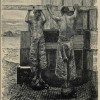Darjeeling
Darjeeling is a town and a municipality in the state of West Bengal, Eastern India. Located in the Lesser Himalayas, it is particularly noted for its tea production. Darjeeling tea is frequently ranked as one of the world’s most popular teas. The British took control of the region in the nineteenth century from the Kingdom of Sikkim. In 1947, Darjeeling merged with West Bengal.
Coordinates
Latitude: 27.038114505557
Longitude: 88.263061512268
Longitude: 88.263061512268


